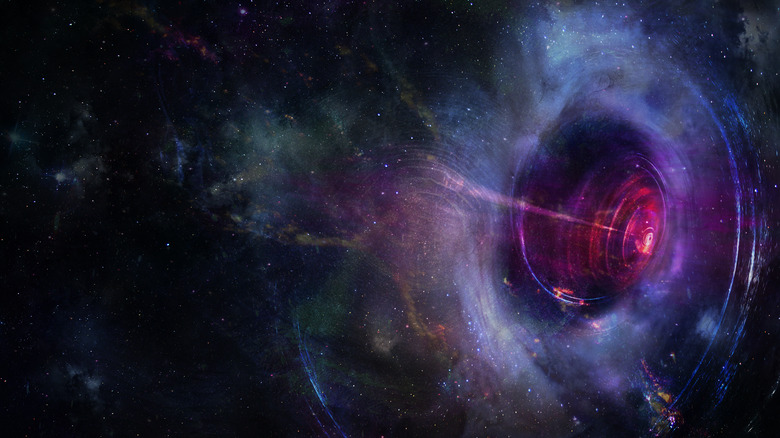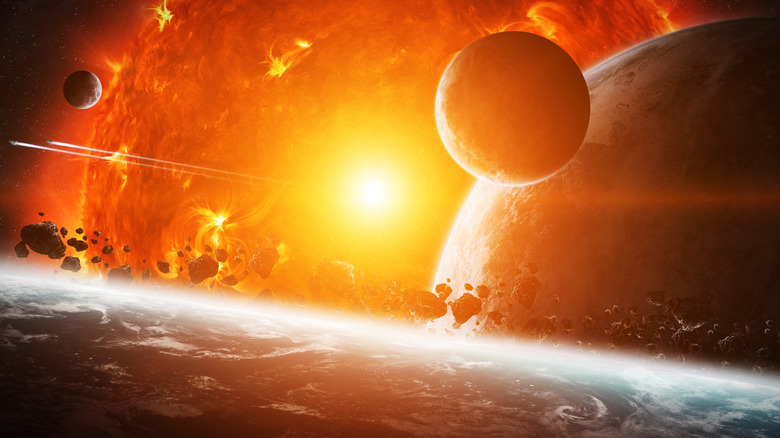The Destruction Of The Universe May Have Already Begun. Here's Why
Imagine for a second that old Norse tales of Ragnarok are, in some way, prophetically true. In a final, apocalyptic showdown, gods and giants clash and annihilate all life everywhere. Not a dinosaur-killing extinction event like the Chicxulub impactor that struck Earth 66 million years ago (per Live Science), not a solar system-consuming ultramassive black hole. We mean every glint of matter, photon of light, even the constituents of reality itself, like gravity, erased. Nothing to exist, or ever exist, ever again.
This is "vacuum decay," as Space explains. Far from an overblown bit of scientific pedagogy confined to theoretical hype circles, this is a genuine possibility. The good news? If vacuum decay hits Earth, you'd never notice. You'd be vaporized before you even realize it. It might be on its way now, expanding forever from a single point at the speed of light, unable to be stopped, stripping the universe of all matter and energy. (Have fun sleeping tonight.)
How is this possible? At its core, you can understand vacuum decay by looking at a simple object: a ball. Toss it up, and what happens? It falls to the ground. It wants to lose energy at all times, and exist in a state of rest. The whole universe is just the same. But as it turns out, the cosmos might still be on its way to the ground.
Hanging out and full of energy
Individual molecules operate the same way as a ball tossed into the air. Electrons (negatively charged particles) live in shells around the nucleus of an atom. The nucleus is made up of protons (positively charged particles) and neutrons (particles with no charge). If an electron jumps to a higher energy level? No problem. If it jumps down, though? The atom has to physically jettison something to "lose" its energy (Kansas State University has a handy summary). This is why you can "see" things, for example, because lost energy moves in waves. These waves have different lengths that look "red," "yellow," and so forth in your brain (and your brain alone).
Imagine the entire universe operates the same way. The cosmos is permeated by blankets of energy called "quantum fields." Quantum fields are responsible for defining gravity, electromagnetism, the weak force, and the strong force. These the four forces that create all the rules of chemistry and physics that define reality.
We assumed, because the universe appears to be a pretty stable system, and has been stable for about 13 billion years (per Space), that our universe's quantum fields were already at rest. Low energy, just hanging out, with nothing more to lose. They're a ball on the ground. As it turns out, though, they might not be.
Living in a false vacuum
What happens if a quantum field loses energy? If a ball hits the ground, it creates a vibration. In the same way, a lowered point in a quantum field's would push other points down to lower energy levels, and so on, in an unstoppable cascade. It would create a bubble of annihilation tearing apart the "fabric of reality," as a sci-fi movie might put it. What would be on the inside of the bubble? We'd have no idea, as Big Think describes. Gravity, electromagnetism, and the weak and strong force would operate differently in a universe-wide lower-energy quantum field. And if they operate differently, who knows if the simplest atom could even exist?
If we live in a state of higher-than-expected energy, then we live in what's called a "false vacuum" (nothing to do with the vacuum of space). The bubble of doom would essentially be the universe's "true vacuum," meaning this whole cosmos could just be a temporary, 13.8-billion-year-old (at present) state.
A particle called the Higg's boson — sometimes referred to as "the God particle" (much to some researchers' annoyance, per Space) — gave us a clue that we might be living in a false vacuum. The Higg's field that the particle is associated with seems to have more mass than it should (also per Space). The upside? Because the universe is expanding faster than the speed of light, it's possible that a true vacuum bubble might never reach us. Fingers crossed.


